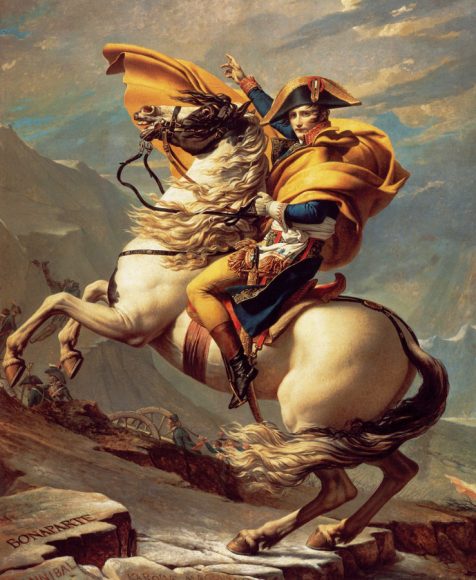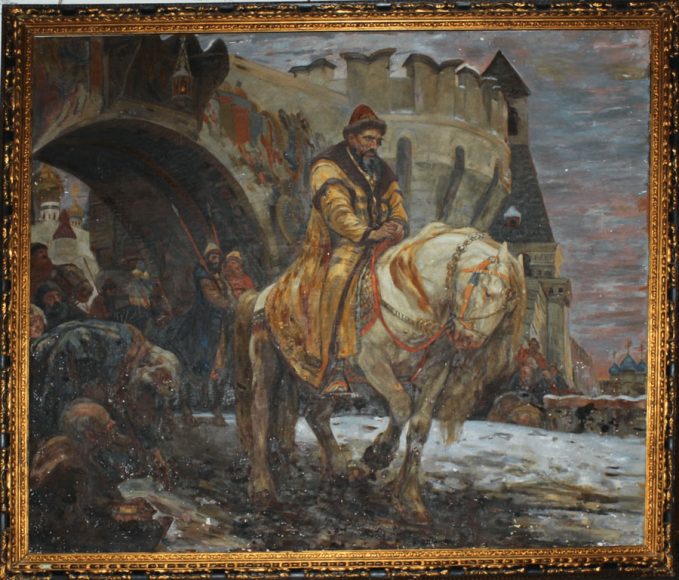The painting depicts Russian Czar Ivan the Terrible leaving Moscow for a monastery — and abdication — on Dec. 3, 1564 as a ruse to force the hapless nobles to give him absolute power, which they would live to regret. With free rein, Ivan instituted the Oprichnina, both a stronghold and a period (1565-72) in which none were safe from the oprichniki, the czar’s secret police.
But the story behind Mikhail N. Panin’s “Secret Departure of Ivan the Terrible Before the Oprichina (sic)” (1911) — also one of flight and oppression — is just as intriguing as the tale the painting offers.
For years the 7½-by 8½-foot oil on canvas held pride of place in a gallery space that Gabby and David Tracy created in their Ridgefield home, the painting having been left behind in David’s first Ridgefield house in 1987. Looking to enhance their retirement, the couple put it up for sale in 2017, only to get a tremendous shock from The Potomack Co. auction house in Alexandria, Virginia: The work was stolen by the Nazis in 1941 from what is now the Dnepropetrovsk Art Museum in Dnepropetrovsk, Ukraine, where Panin eventually settled. That provenance particular resonance for Gabby, a Holocaust survivor whose father, Samuel Weiss, died in a concentration camp.
How the work made its way with a former Swiss border guard to Ridgefield — where he lived until 1962, leaving the painting behind for the new homeowners just as they did for David — remains a mystery. Today, it’s in the hands of the U.S. government, which is seeking to return it to Ukraine, with the Tracys’ blessing.
But in the Russian nesting doll of narratives that is art history, “Secret Departure of Ivan the Terrible” is not merely a Nazi-looted work. It is also part of a genre — the man on horseback — that sweeps us from the ancient world to our own time. It has become a symbol of the controversy over Confederate monuments as well as a metaphor for dystopia.
“The horse and rider have long been a sign of majesty and power,” says Livia Straus, co-founder (with husband Marc) of the Hudson Valley Museum of Contemporary Art in Peekskill, where Djordje Ozbalt’s dystopian equestrian painting “Great Liberator” (2011) is on view through April 21. “The horse and rider being so identified with each other, it’s as if they are one.”
Though rulers on horseback figure into ancient Middle Eastern art and the famed Chinese Terracotta Army shows cavalrymen beside their mounts, the man on horseback takes off with the ancient Greeks. As discussed in the recent “Equus: Story of the Horse” on PBS’ “Nature” (Page 108), the ultimate man on horseback was the mythical centaur, half-man, half-horse. Perhaps the most famed of these was Chiron, whose nurturing tutelage of the warrior Achilles as a child — the boy often tenderly on the centaur’s back — is a subject found throughout the history of Western art.
It was Achilles’ purported descendant, Alexander the Great, who would inspire a host of equestrian depictions, from Edinburgh to Thessaloniki — thanks to his bond with the equally legendary Bucephalus, a big black stallion whom Alexander tamed as a boy by turning the bucking animal away from the sun so he could no longer see his shadow.
Alexander astride the rearing Bucephalus, sword in hand — as seen in a 1st century B.C. bronze statuette, a Roman copy of a work by his sculptor, Lysippos, that was found in the ruins of Pompeii in 1761 — would be a template for Jacques-Louis David’s 1801 oil on canvas, “Napoleon Crossing the Alps.” Similarly, the 2nd century bronze of the Roman Emperor Marcus Aurelius aboard his steed on the Capitoline Hill in Rome — right arm outstretched, the horse’s front right leg raised to canter — would become a prototype of heroic Renaissance equestrian sculptures.
In the U.S., the epic man on horseback has often been a prominent figure from the young nation’s early history, as in Anna Hyatt Huntington’s dramatic statue of Revolutionary War Gen. Israel Putnam in Redding’s Putnam Memorial Park. (Sometimes it has even been an epic woman on horseback as in Huntington’s “Sybil Ludington” (1960) at Carmel’s Lake Gleneida and the Danbury Public Library, honoring the Paul Revere of Putnam and Fairfield counties.)
Even though Putnam is shown making his daring 1779 escape from the British on horseback — down a staircase representing 100 Greenwich steps — the emphasis is on ultimate victory. And to the victor go not only the spoils but the equestrian monuments. It is among the bones of contention in the debate over the Confederate monuments, which critics say celebrate the vanquished as well as the cause of slavery, in which there is nothing heroic.
In modern times, artists have upended the commanding quality of the man on horseback. In certain moments, he is contemplative. (See Huntington’s “Young Abe Lincoln” (1961), which finds the future president lost in a book as his horse moseys along outside the Bethel Public Library.)
In other moments, he is defeated. Perhaps nowhere has this been captured more poignantly than in “End of the Trail” (1918), a bronze by James Earl Fraser, who lived in Westport. An Indian, exhausted, sits slumped over his horse, his legs dangling. The downward curve of his body mirrors the slope of the equally exhausted horse’s head, serving as a counterpoint to all those ascendant Alexandrian figures. It is the end of the trail not only for him and the animal that has served him so faithfully, but for a way of life.
Back at Hudson Valley MoCA, Ozbolt’s “Great Liberator,” an acrylic on canvas, upends the man on horseback quite literally, mocking the romance of the conquering hero by standing the equestrian figure on its head amid a city in twilight.
It’s a reference to the personal history of the Serbian artist, who has seen regimes come and go, says Livia Straus, Hudson Valley MoCA’s director emerita. But the work also speaks to something larger — “the ebb and flow of power,” says Effie Phillips-Staley, the museum’s executive director.
“A monument implies permanence,” she adds. “This is about the precarious state of power.”
Yet rider and horse endure. In the critically acclaimed new film “The Mustang,” Matthias Schoenaerts stars as a violent Nevada inmate given a chance to break and train an equally angry mustang and reconnect with the human race after a long stint in solitary. (It’s based on the Wild Horse Inmate Program found in several Western states.)
Brutal and brutalized, man and horse must find a way together to transcend in a crucible of humility, redemption and love.






